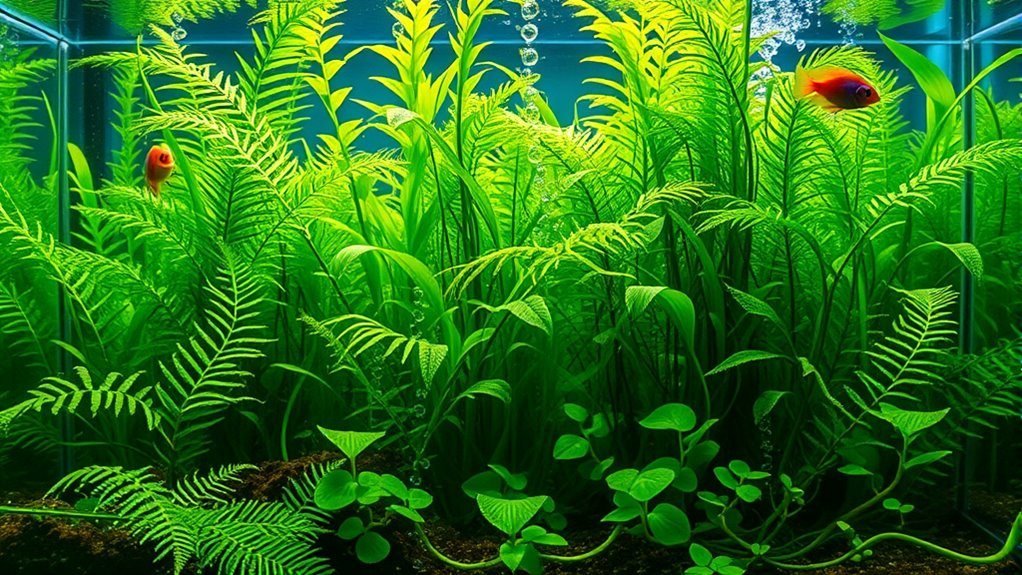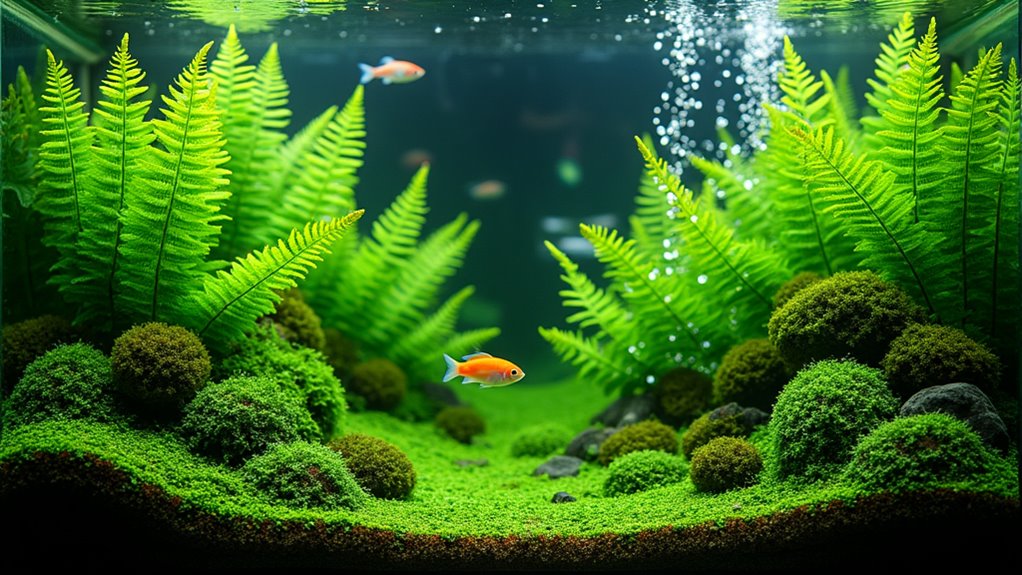Live plants in your aquarium create natural habitats that boost your fish’s well-being. They offer hiding spots, reduce stress, and encourage natural behaviors like grazing and exploring. Plants also improve water quality by absorbing waste and stabilizing key parameters. With different growth patterns, they keep the environment dynamic and healthy. If you want a vibrant, thriving tank, understanding how plants benefit your fish is essential—you’ll discover more about building a balanced ecosystem.
Key Takeaways
- Live plants create natural hiding spots and territories, reducing fish stress and encouraging healthy behaviors.
- They help maintain water quality by absorbing nitrates and waste, promoting a balanced aquatic environment.
- Proper plant selection enhances tank aesthetics and provides diverse habitats for different fish species.
- Plants stabilize water parameters and prevent algae overgrowth, supporting overall tank health.
- Different growth patterns offer shelter and exploration opportunities, fostering active and engaged fish.

Ever wondered how to transform your aquarium into a vibrant, healthy ecosystem? The secret lies in understanding how live plants influence your fish and the environment they thrive in. One of the key factors to weigh is fish behavior. Fish tend to interact differently in tanks with live plants compared to those without. When you introduce the right plants, you create hiding spots, territories, and resting areas that mimic their natural habitat. This reduces stress, which in turn promotes natural behaviors like grazing, exploring, and breeding. Observing your fish’s activity can guide you in selecting plants that suit their needs, ensuring they feel secure and comfortable. For example, shy or timid fish often seek shelter among dense foliage, so choosing plants like Java fern or Anubias can give them a sense of security. Conversely, active swimmers may appreciate open spaces alongside taller plants for swimming and grazing, making your tank more dynamic and engaging.
Plant selection plays an essential role in shaping the behavior of your fish. Not all plants are suitable for every tank, so understanding their growth habits, light requirements, and compatibility with your fish is vital. Hardy, low-maintenance plants like mosses or cryptocorynes are excellent choices for beginners because they adapt easily and require minimal care. These plants not only serve as hiding spots but also help maintain water quality by absorbing nitrates and other waste products. When you select plants thoughtfully, you also influence your fish’s feeding habits. Herbivorous species, for example, benefit from plants that they can nibble on, reducing the need for supplemental feeding and encouraging natural foraging behavior. Additionally, the presence of live plants can help stabilize water parameters, making the environment more predictable and less stressful for your aquatic friends. Ensuring proper installation and maintenance is crucial for maximizing these benefits and preventing issues like algae overgrowth or plant decay.
As you decide on plant varieties, consider how their growth patterns impact fish behavior. Fast-growing plants can create quick cover and provide constant shelter, while slow-growing species might require patience but offer long-term stability. Mixing different types of plants can create a layered environment that caters to various behaviors, from hiding to exploring. By thoughtfully selecting plants based on your fish’s personality and habits, you foster a balanced ecosystem where natural behaviors flourish. In turn, your fish will be healthier, more active, and more engaged with their surroundings. This symbiotic relationship between plant selection and fish behavior underscores why live plants are such an invaluable addition to any aquarium. They not only beautify your tank but also support your fish’s well-being, making your aquatic setup truly thrive.
Frequently Asked Questions
How Do I Choose the Right Plants for My Specific Fish Species?
When choosing plants for your tank, consider your fish’s compatibility and their activity levels. Some species prefer hiding spots, while others thrive in open spaces. Check each plant’s lighting needs and match them with your setup’s plant lighting to guarantee healthy growth. Research your fish’s behavior and environmental needs, then select plants that complement their habits, creating a balanced and stress-free environment for your aquatic friends.
What Are the Maintenance Requirements for Live Aquarium Plants?
You need to stay on top of maintenance for your live aquarium plants by establishing regular fertilizer schedules to promote healthy growth. Make sure to meet their lighting requirements, providing adequate light without overdoing it, which can cause algae issues. Trim dead or overgrown leaves regularly, and monitor water parameters to keep conditions ideal. Consistent care helps your plants thrive, creating a beautiful, balanced environment for your fish.
Can Live Plants Prevent Algae Growth in My Tank?
Live plants can help prevent algae growth in your tank through effective algae control. They compete with algae for nutrients and light, reducing the chances of algae overgrowth. By establishing healthy plant competition, you create an environment where algae struggle to thrive. Make sure your plants receive proper lighting and nutrients to maximize their algae-fighting benefits and keep your tank clean and balanced.
How Do I Plant and Anchor Aquatic Plants Properly?
When planting aquatic plants, you should use proper planting techniques to guarantee they thrive. Gently insert roots into the substrate, making sure they’re secure without damaging them. For anchoring methods, use plant weights or tie them to rocks or driftwood if needed. Avoid overcrowding, and position taller plants behind shorter ones for a natural look. Regularly check your plants, adjusting anchoring as they grow to keep them stable.
Are There Any Common Pests or Diseases Affecting Aquarium Plants?
You should be aware of common pests like snails and algae, which can harm your plants, and diseases such as mold or rot. Pest identification helps you catch issues early, and practicing disease prevention keeps your plants healthy. Regularly inspect your plants, avoid overfeeding, and maintain good water quality. If you spot pests or signs of disease, act quickly to remove affected plants and treat the tank, ensuring a thriving aquatic environment.
Conclusion
By bringing beautiful, beneficial aquarium plants into your tank, you boost balance, breathe life, and banish boredom. Plants provide a pristine, protected environment, promoting healthier habitats and happier fish. With a bit of care and curiosity, you create a mesmerizing, colorful corner of calm. So, seize the chance to transform your tank into a thriving, tranquil tableau—where plants and fish flourish together, fostering a fabulous, flourishing freshwater world.










